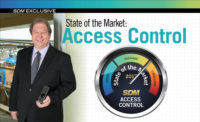Leading Standards
One development helping move the industry forward is the rise and increasing acceptance of standards. A more secure successor to Wiegand, open supervised device protocol (OSDP), for example, has been around for a while but suddenly gained traction in the past year.
“It has taken that long for OSDP to gain momentum, but we have seen a big uptick in the last year to 18 months of people requesting OSDP information,” says Mercury’s Matt Barnette. “We have been supporting OSDP in our products for about 10 years, but in the beginning of 2018 there was an update to our panels to meet the new OSDP v1.2, which provides even higher levels of encryption.”
IST’s Christine Lanning says her company is working with one customer already whose needs were driven by OSDP. “We are in the process of forklifting an access control system. This is the first time we have seen a non-government customer ask about that.”
OSDP is just one standard or protocol trying to change the access control industry. The PSIA physical logical access interoperability (PLAI) spec is another, as is ONVIF, which began to look at the access control market in 2012 after having success in the video space. Its latest profile for access control, Profile A, was released over a year ago, but Bob Dolan, director of technology for security solutions for Anixter and a member of the ONVIF Technical Services Committee, acknowledges it is just a start. “We realize we have a long way to go to help the industry develop a full standard for access control.”
Tim Vahary, marketing and product manager for RS2, Munster, Ind., says standards are the future of the access control industry. “Standards such as PLAI, ONVIF, OSDP and BACnet have opened the door to being able to integrate a variety of different systems using a single method across the board.”
Tony Diodato, founder and CTO of Cypress Integration Solutions and co-chair of the SIA OSDP Working Group, is encouraged by what he is seeing around standards lately, but says there is still far to go. “While the wave is heading into shore, we’re not yet feeling the full impact of standards such as OSDP. What we’re seeing is an uptick in conversations with end users, integrators and manufacturers because they are recognizing these standards will allow them to overcome limitations and provide end users with better value, while increasing profit.”
However, he adds, there is one very encouraging trend: “Standards are changing the process of how we integrate evolving technologies into access control. This is the first time in my experience that the standards are at the leading edge of the wave, not the trailing edge.”
What Will the Mercury Acquisition Mean for the Industry?
The security industry is no stranger to mergers and acquisitions. However, one of the more prominent transactions that occurred in late 2017 was when HID (whose own parent company is ASSA ABLOY) purchased Mercury Security, an OEM supplier of open-protocol controllers to many of the major players in the access control industry. Vendors and integrators alike wondered what that would mean for their own relationships with Mercury.
SDM spoke with Matt Barnette, vice president, Mercury Security, and HID global accounts to get answers straight from the source.
SDM: How did the acquisition go from your perspective?
Barnette: I don’t think the acquisition could have gone any better looking back. I think history has shown some of these acquisitions don’t go so well, but HID has a lot of experience in this area. They have been very conscious of keeping Mercury on a successful path. We have maintained contact with our customer base, and the team has been kept in place. It has really been business as usual as far as we are concerned; and if you talk to Mercury customers I think they would say same thing.
SDM: Have you gotten any feedback from customers about the acquisition?
Barnette: Some were surprised by the announcement; but when they thought about it, it makes sense. HID is already doing business with most of the same customers Mercury does. We are kind of like Switzerland. We play with companies that have their own access control products as well as HID customers, and customers with their own reader technology who also use HID technology.
SDM: What does this partnership bring to Mercury?
Barnette: HID has been very good about making sure we have the foundation to continue to grow business under their guidance. We think of HID as being a card and reader company but when you really look, it is pretty vast. We are exploring how to leverage all these world-class products under the HID umbrella and bring to market things that no one else can develop. That will be one of the benefits as we develop a roadmap for a more integrated experience for both integrators and end users.
3 Tips for Succeeding in a Disruptive World
As emerging technologies spread into boardrooms, it is not just the technologies themselves that are disruptive. It’s the scaling and adoption of those technologies that are also vulnerable. Artificial intelligence, advanced robotics, augmented reality, Internet of Things and virtual reality have been around since the early 2000s. What we see now versus then is that our business model enablers have evolved to drive the technology through a business, making the impact of technology truly disruptive on a large scale.
Here a few tips to be ready for these and more changes, when they come. (To read the full article “How Advances in Video Games, Cell Phones and Televisions Will Disrupt Commercial Security” visit www.SDMmag.com/Advances-disrupt-security.)
1. Invest in a diverse team to lead your innovation and technology vision. Hiring talented individuals who live technical lives at home will help your culture change when they bring their experience to work.
2. Listen to and embrace feedback. Create channel communities and hold voice-of-the-customer events to learn what your customers need and want. Events will teach you not only what your customers need, but where you need to get smarter as an organization.
3. Build systems that are native to the mobile operating system. Be sensitive to privacy issues, and apply encryption to secure your solutions. At the end of the day, it’s all about the user experience.
As commercial technology evolves to the consumer level, you will need to find ways to provide value to end users. Use knowledge to become your customer’s trusted advisor. Creating a vision in partnership with your clients will help you both set up a roadmap to a future-proof security solution, and will create a relationship that will last for years. — Contributed by Kim Rahfaldt, director media relations, AMAG Technology
New Access Technology & the Government
Federal agencies, including the Department of Defense, have shown interest in the idea of providing the right individuals access to the right resources at the right time — for the right reasons. Recently updated regulatory requirements in the Federal Identity, Credential and Access Management (FICAM) effort, issued and managed by government authorities, have been a significant step in this direction since first being introduced in 2009. With time, this converged and successful model will be adopted by state and local governments, utilities and other highly regulated industries here and around the globe.
Access control is moving to the cloud deployed under an Infrastructure-as-a-Service (IaaS) model. This configuration can reduce or eliminate the need for onsite server hardware as well as the need for multiple client software installations and updates. The federal government is broadly doing this today with other applications, such as dedicated “Gov Cloud” solutions from Microsoft, Google and Amazon. In addition, The Federal Risk and Authorization Management Program (FedRAMP), which provides a standardized approach to security assessment, authorization and continuous monitoring for cloud products and services, is facilitating the shift from older, insecure, tethered systems to more robust, approved and nimble cloud offerings, providing significant cost savings.
These cloud-based systems are leading to new credentialing solutions. The cloud is ideal for supporting mobile credentials and readers, allowing employees to use their mobile phones as their access control card. While not used yet in the federal government, the National Institutes of Science and Technology (NIST) is looking at it. To enroll a cardholder, the badge invitations are sent to a cloud server. Users then receive an email with a link to a downloadable smartphone app as well as an authorization code to activate the credential. Because smartphones require a security code or biometric for access, as well as possession of the phone, app and downloaded credential, this solution can provide multi-factor authentication. Also, mobile credentials can be remotely issued, transferred and deactivated.
Not all federal agencies or other enterprise organizations fit into a single access control solution. That’s why leading manufacturers and other suppliers are constantly monitoring government regulators, offering suggestions while making changes to ensure they provide end users with the right access control solutions to address their complex security challenges into the future. — Contributed by Ryan Kaltenbaugh, vice president, federal government solutions, Lenel, part of UTC Climate, Controls & Security, a unit of United Technologies Corp.
How Advances in Video Games, Cell Phones & Televisions Will Disrupt Commercial Security
Your virtual assistant can notify you of today’s weather, top news stories, traffic conditions and the time it will take to get to your first appointment. The assistant opens your blinds, turns on the kitchen lights, sets your thermostat, and plays your morning music playlist throughout the house. You can see the driveway camera on your TV to check if it snowed. When you leave for the day, it sets the daytime temperature of the house, turns off the lights, turns off the TV, disarms the alarm, unlocks the front door, and opens the garage door. As you leave, the front door automatically locks, the alarm is armed and the garage door shuts.
While this sounds like a state-of-the-art, expensive home automation set-up, it’s the complete opposite. This experience can be built with a simple DIY Apple Home Kit setup with devices purchased at the local electronics store for less than $800, and best of all, the software is free. This seamless experience is controlled by your voice. People are living this life now.
When you arrive at your client’s office, it’s like a step back in time. The front door is propped open because everyone forgets their badges at home. In the reception area, there is no receptionist or intercom. A sign asks you to sign the paper visitor logbook and call your host using the lobby phone. When your host arrives, he hands you a badge that has access to all doors throughout the building 24/7. The conference room he brings you to is 10 degrees colder than the rest of the office. Your host leaves and tries to find the thermostat that controls the room, but can’t figure out which one it is.
The next generation of employees is going to expect that they have the same connected experience in the office as at home. And the next generation of corporate security officers will make that a reality. What does this mean for security integrators and manufacturers?
The critical driver of disruption is the speed at which consumers or businesses adopt a new product or service. The perfect storm of emerging technology, new business models to distribute it quickly, and subsequent exponential adoption means that organizations must get more agile and must be able to respond and anticipate.
As emerging technologies spread into boardrooms, it is not just the technologies themselves that are disruptive. It’s the scaling and adoption of those technologies that are also vulnerable. Artificial intelligence, advanced robotics, augmented reality, Internet of Things and virtual reality have been around since the early 2000s. What we see now versus then is that our business model enablers have evolved to drive the technology through a business, making the impact of technology truly disruptive on a large scale.
Business model enablers such as cloud services, miniaturization of sensors, low-cost computing, application programming interfaces, crowdfunding, open source and Freemium mean we now have access to the funding, platforms, processing power, software and data to turn the technology into useful, scalable solutions.
The combination of new technologies, together with these new business model enablers, is resulting in significant change in the adoption rates of new technology-enabled companies, products, and services. Technology companies are crossing over into different areas, and getting the right technology at a cheaper price is becoming easier.
People are consuming things differently today. Users want the same content, but in a different way. Virtual assistants are becoming more accepted at home. How soon until they control security? PC usage is down and app usage has soared. Understanding “user experience” is the secret sauce to success.
In our “I want it now” culture, security integrators and manufacturers need to be nimble and responsive by using the tools end users are accustomed to using in their daily lives. In the home automation space, if you have an issue, you can instantly call, find Web support, chat, email, voice, etc., and remotely resolve issues. Integrators and manufacturers need to harness the disruptive technology to provide the instant support end users experience in their everyday lives.
Internet of Things is one of the biggest disruptors that security integrators and manufacturers can use to their advantage. With the ability to self-configure and create automation, end users can self-customize. Adding devices is simple, and everything is connected. Savvy end users do not want to call a technician every time they want to make a change to their system. End users are taking more control. As the commercial security industry evolves, it is imperative to leverage the trends to bring greater value to customers.
To keep up with the user demand and provide a secure data environment for customers, the industry needs to increase cyber capabilities. End users are increasingly looking for technology with open architecture to meet their desire to self-customize quickly. In the security or commercial space, customers frequently worry about security breaches, and end-to-end encryption must be used for everything along with opt-in models.
In two to five years, what we see today in the consumer space will be the norm. Manufacturers need to balance their core offerings and figure out how to be disruptive.
Bringing innovation to your customers will require you to invest in a diverse team to lead your innovation and technology vision. Hiring talented individuals who live technical lives at home will help your culture change when they bring their experience to work. You must understand generational differences and work to provide a common ground. If you are able, budget for a lab and provide technology allowances for a select team to use technology at home to understand the experience. Leverage everyone in the organization for their thoughts, ideas and experiences.
Listen to and embrace feedback. Create channel communities and hold voice-of-the-customer events to learn what your customers need and want. These events will teach you not only what your customers need, but where you need to get smarter as an organization.
Build systems that are native to the mobile operating system. Be sensitive to privacy issues, and apply encryption to secure your solutions. At the end of the day, it’s all about the user experience.
As commercial technology evolves to the consumer level, you will need to find ways to provide value to end users. Make yourself available to your customer, listen to their needs, and sell value. Use knowledge to become your customer’s trusted advisor. Understand the connected experience and know what your customer will want sooner rather than later. Sell value, not widgets, and sell systems that connect to each other. Creating a vision in partnership with your clients will help you both set up a road map to a future-proof security solution, and will create a relationship that will last for years. — Contributed by Kim Rahfaldt, director media relations, AMAG Technology







